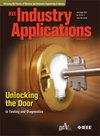Community-Based Transactive Coordination Mechanism for Enabling Grid-Edge Systems
IF 4.5
2区 工程技术
Q2 ENGINEERING, ELECTRICAL & ELECTRONIC
引用次数: 0
Abstract
The changing landscape of the electricity industry, characterized by a surge in distributed energy resources (DERs) and proactive customers, necessitates practical solutions for coordinated operation especially at the distribution-level. This paper introduces a community-based transactive coordination mechanism designed to incentivize customers for providing localized and system-level services reflected through real-time prices. The work presents a bidding approach for communities, representing collectives of customers, to formulate their price-responsiveness for retail energy coordination, emphasizing a community-centric model. By sending bidding curves to a third-party, the mechanism enables customers with DER assets to actively participate in localized coordination with the Load Serving Entity (LSE), supplementing each other’s and even the utility’s needs through a shared energy economy. The proposed transactive mechanism is implemented leveraging a co-simulation framework that integrates a distribution grid simulator with control agents for performance evaluation. Simulation-based evaluation on a real distribution system use-case, in collaboration with a local utility, demonstrate the potential of the mechanism to reduce energy costs up to 12% for communities with DERs like solar photovoltaic (PV) and battery energy storage systems (BESS). The mechanism’s effectiveness is further validated through field tests conducted on a utility’s real system, utilizing a 1.32 MWh battery resource.基于社区的网格边缘系统交互协调机制
以分布式能源(DERs)和主动客户激增为特征的电力行业不断变化的格局,需要切实可行的解决方案来协调运营,特别是在配电层面。本文介绍了一种基于社区的交互协调机制,旨在通过实时价格来激励客户提供本地化和系统级服务。这项工作为代表客户集体的社区提出了一种投标方法,以制定零售能源协调的价格响应能力,强调以社区为中心的模式。通过将投标曲线发送给第三方,该机制使拥有DER资产的客户能够积极参与与负载服务实体(LSE)的本地化协调,通过共享能源经济来补充彼此甚至公用事业公司的需求。所提出的交互机制是利用一个联合仿真框架来实现的,该框架将配电网模拟器与用于性能评估的控制代理集成在一起。与当地公用事业公司合作,对一个真实配电系统用例进行了基于模拟的评估,展示了该机制的潜力,可以为拥有太阳能光伏(PV)和电池储能系统(BESS)等DERs的社区降低高达12%的能源成本。该机制的有效性通过在公用事业公司的实际系统上进行的现场测试进一步验证,利用1.32兆瓦时的电池资源。
本文章由计算机程序翻译,如有差异,请以英文原文为准。
求助全文
约1分钟内获得全文
求助全文
来源期刊

IEEE Transactions on Industry Applications
工程技术-工程:电子与电气
CiteScore
9.90
自引率
9.10%
发文量
747
审稿时长
3.3 months
期刊介绍:
The scope of the IEEE Transactions on Industry Applications includes all scope items of the IEEE Industry Applications Society, that is, the advancement of the theory and practice of electrical and electronic engineering in the development, design, manufacture, and application of electrical systems, apparatus, devices, and controls to the processes and equipment of industry and commerce; the promotion of safe, reliable, and economic installations; industry leadership in energy conservation and environmental, health, and safety issues; the creation of voluntary engineering standards and recommended practices; and the professional development of its membership.
 求助内容:
求助内容: 应助结果提醒方式:
应助结果提醒方式:


